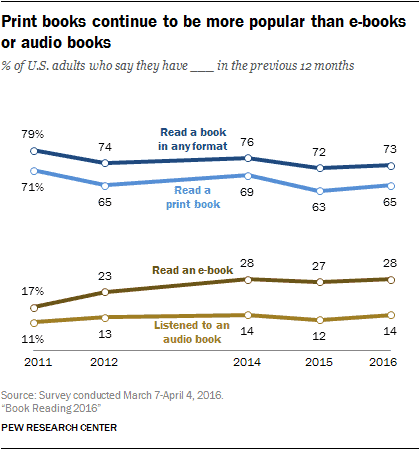
A growing share of Americans are reading e‑books on tablets and smartphones rather than dedicated e‑readers, but print books remain much more popular than books in digital formats, Pew Research Center reports.
"A Pew Research Center survey finds that the share of Americans who have read a book in the last 12 months (73%) has remained largely unchanged since 2012," Andrew Perrin wrote. "And when people reach for a book, it is much more likely to be a traditional print book than a digital product. Fully 65% of Americans have read a print book in the last year, more than double the share that has read an e‑book (28%) and more than four times the share that has consumed book content via audio book (14%)."
"But while print remains at the center of the book-reading landscape as a whole, there has been a distinct shift in the e‑book landscape over the last five years. Americans increasingly turn to multipurpose devices such as smartphones and tablet computers – rather than dedicated e‑readers – when they engage with e‑book content. The share of e‑book readers on tablets has more than tripled since 2011 and the number of readers on phones has more than doubled over that time, while the share reading on e‑book reading devices has not changed. And smartphones are playing an especially prominent role in the e‑reading habits of certain demographic groups, such as non-whites and those who have not attended college."
Retailers should promote the advantages eReaders offer in advertising. Emailed ads and newsletters can be effective in reaching this crowd to remind them why they love their eReaders. AudienceSCAN survey results show 55.8% of eReader Users took action after receiving ads in their inboxes in the past year.
"Americans read an average (mean) of 12 books per year, while the typical (median) American has read 4 books in the last 12 months. Each of these figures is largely unchanged since 2011, when Pew Research Center first began conducting surveys of Americans’ book reading habits."
"E‑book readership increased by 11-percentage points between 2011 and 2014 (from 17% to 28%) but has seen no change in the last two years. Similarly, the share of American adults who listen to audio books has changed only marginally since Pew Research Center first asked about this topic in 2011 – at that point, 11% of Americans had listened to an audio book in the last year, compared with 14% now."
"In total, 34% of Americans have either read an e‑book or listened to an audio book in the last year, but relatively few Americans read books in these digital formats to the exclusion of print books."
Encourage Americans to fuel their passion for reading on eReaders. According to AudienceSCAN data, 50% of eReader Users enjoy reading fiction books or novels in their leisure time. Promote new digital releases in TV spots, because 65.5% of eReader Users took action after seeing a commercial in the past year.
"More than one-quarter (28%) of Americans read books in both print and digital formats (which includes e‑books and audio books). Some 38% read print books but did not read books in any digital formats, while just 6% read digital books but not print books."
"Relatively few Americans are “digital-only” book readers regardless of their demographic characteristics. However, some demographic groups are slightly more likely than others to do all of their reading in digital format. For instance, 7% of college graduates are digital-only book readers (compared with just 3% of those who have not graduated from high school), as are 8% of those with annual household incomes of $75,000 or more (compared with 3% of Americans with incomes of $30,000 or less). Interestingly, young adults are no more likely than older adults to be “digital-only” book readers: 6% of 18- to 29-year-olds read books in digital formats only, compared with 7% of 30- to 49-year-olds and 5% of those 50 and older."
AudienceSCAN data is available as part of a subscription to AdMall for Agencies, or with the SalesFuel API. Media companies can access AudienceSCAN data through the AudienceSCAN Reports in AdMall.
